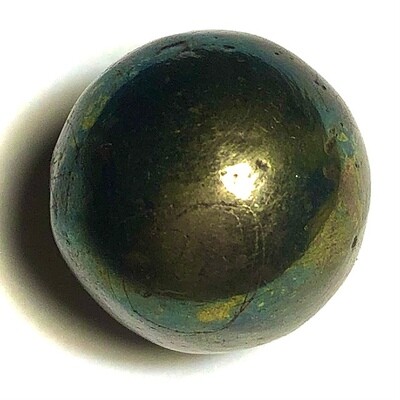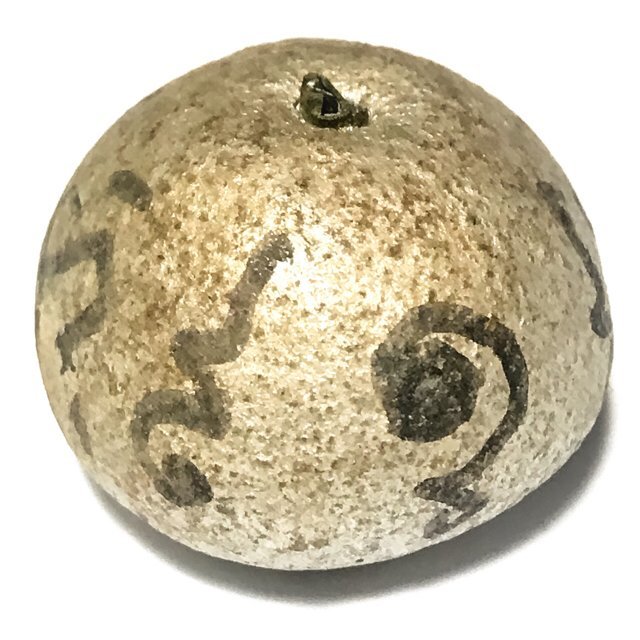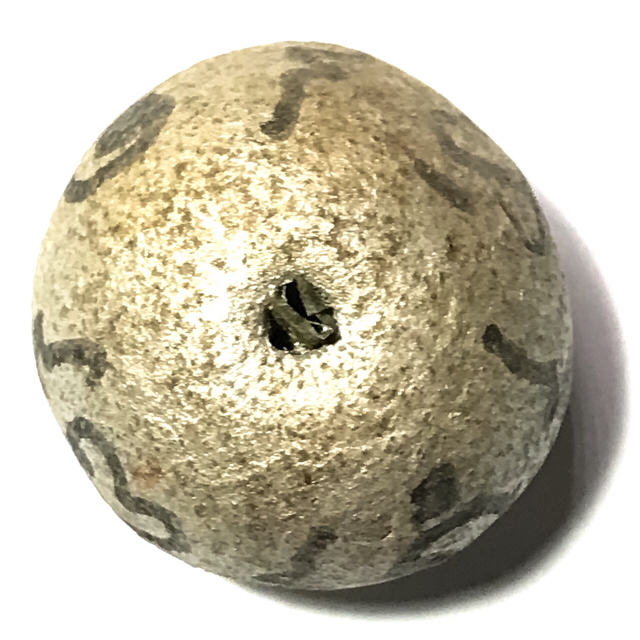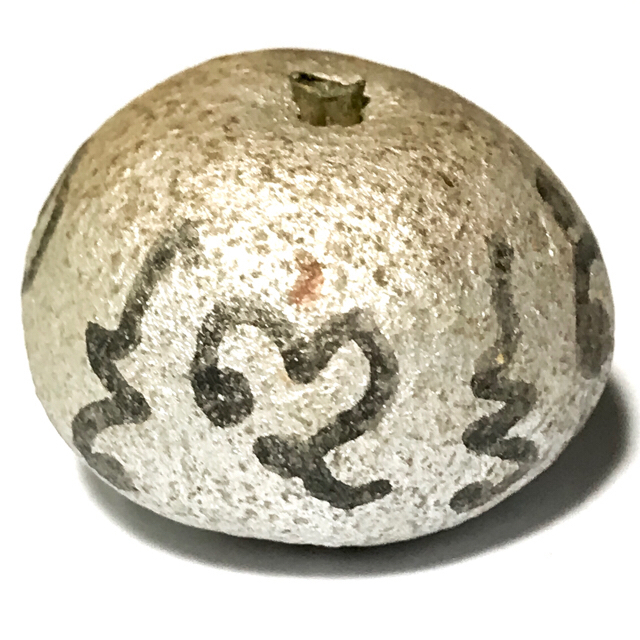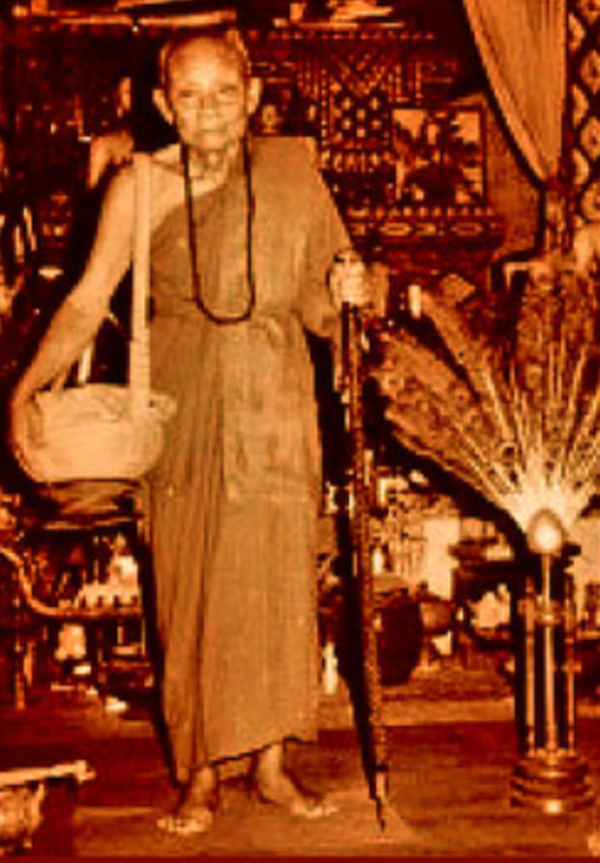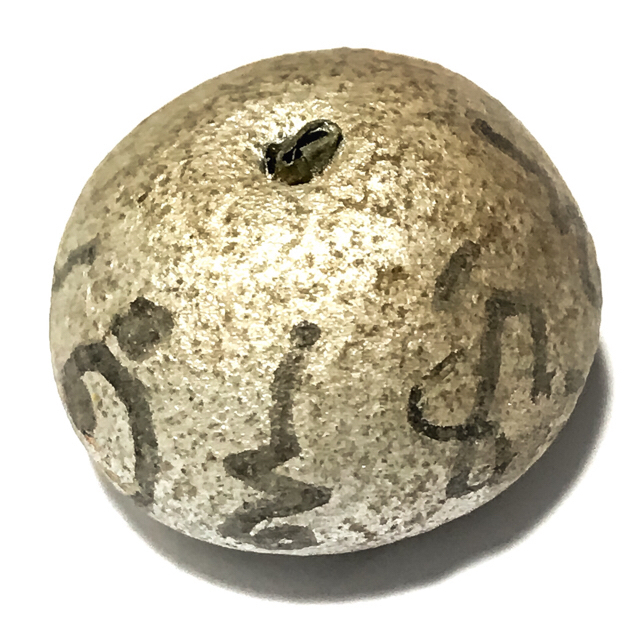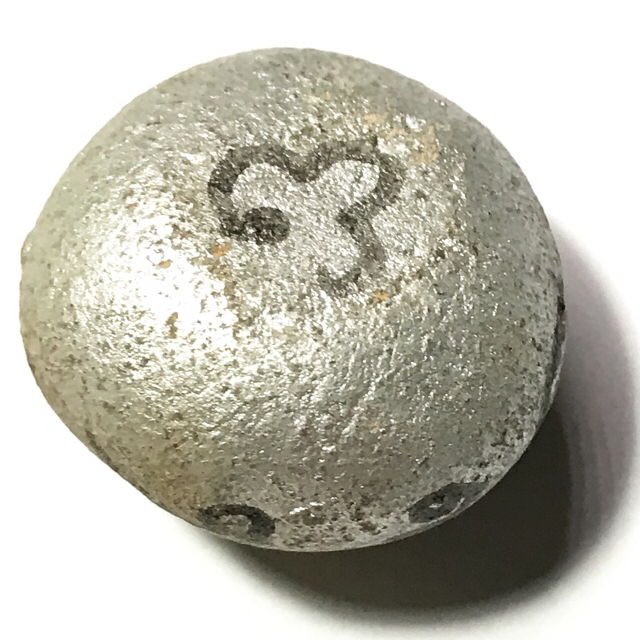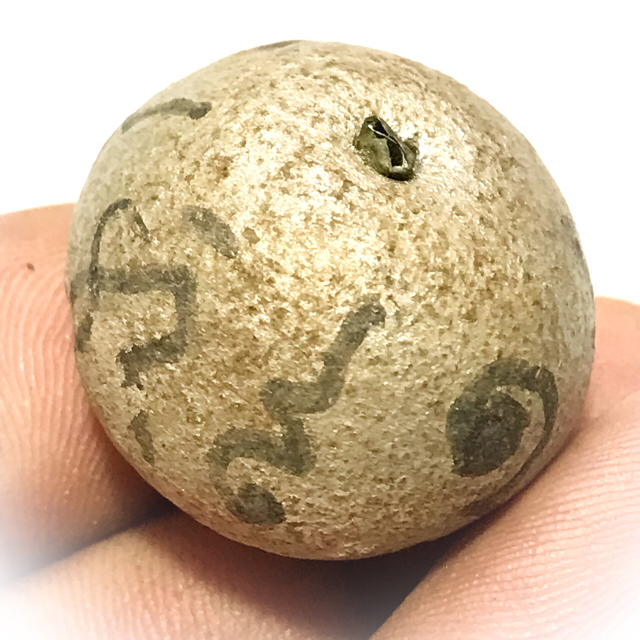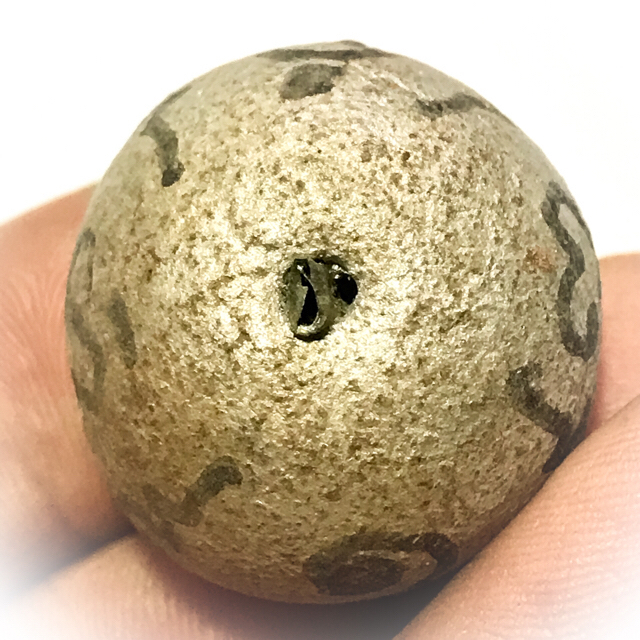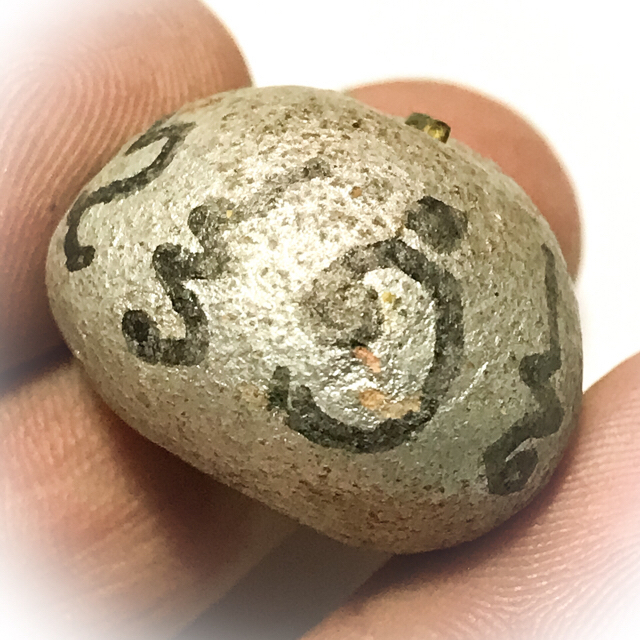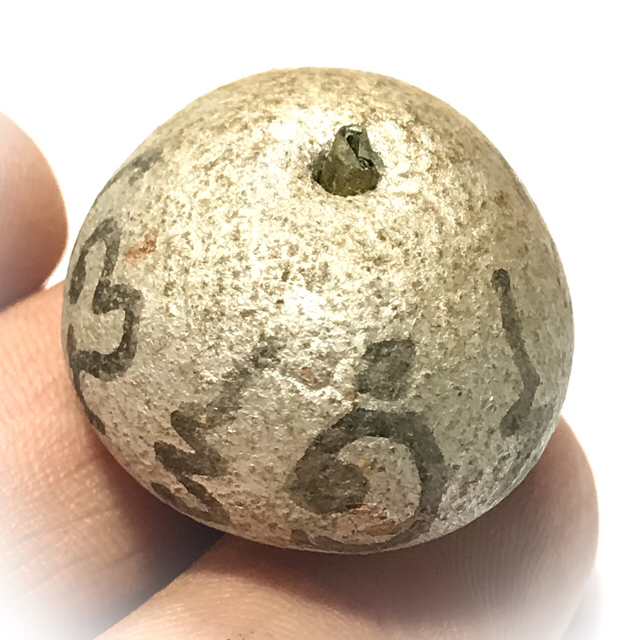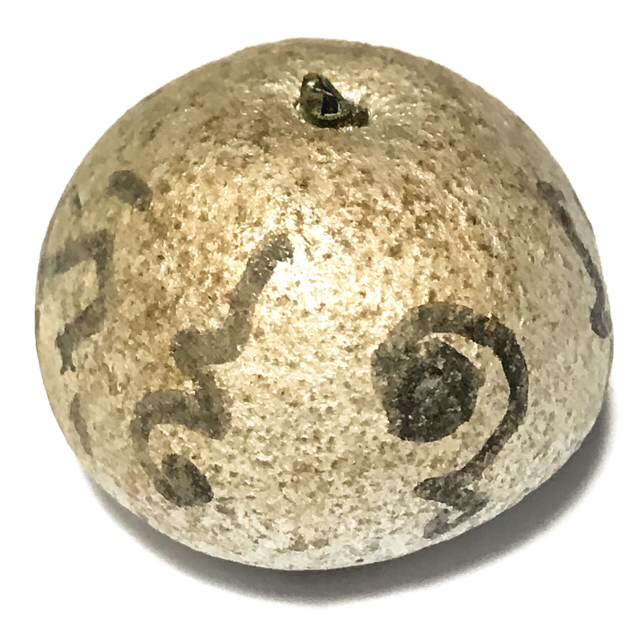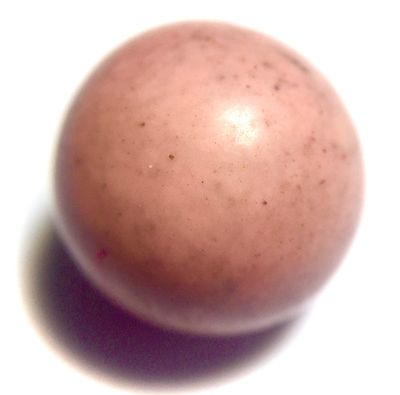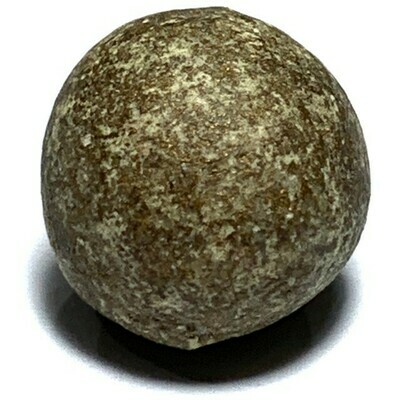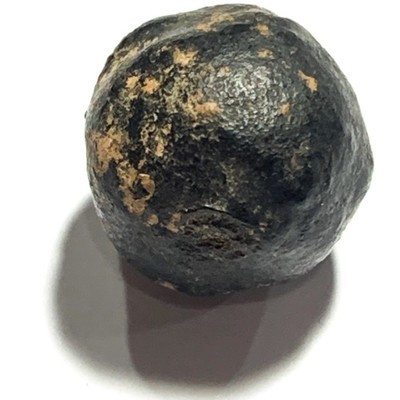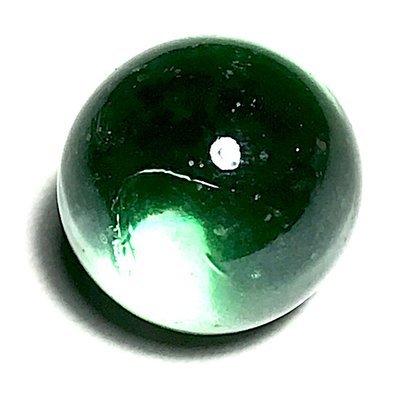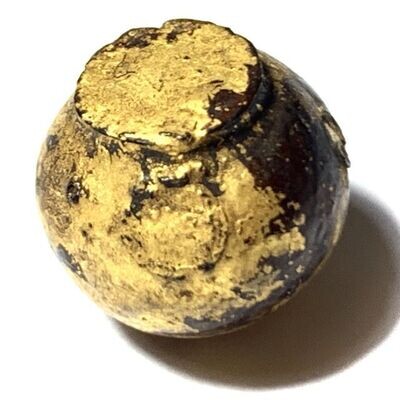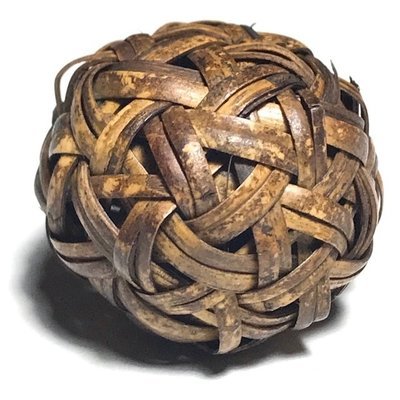Presenting a tiny but powerful and rare classic amulet from one of the Great Khao Or Masters of the 20th Century, Rian Glom Lek Hlang Chedi 2505 BE Nuea Tong Daeng Miniature Guru Monk Coin Por Tan Klai Wajasit
This Sacred amulet of the Great Khao Or Master of Nakorn Sri Tammarat, Master of Wat San Khan and Wat Pratat Noi, is a very rare amulet from Por Tan Klai’s 2505 BE Blessing Ceremony Edition, and is considered a ‘Jaek mae Krua’ type amulet (meaning ‘give to the kitchen maids and temple helpers’), which is suitable not only for men, but due to its miniature size, a perfect amulet for ladies or children to wear.

Rian Glom Lek 2505 BE Por Tan Klai Wajasit Wat Suan Khan
The 2505 BE edition of amulets of Por Tan Klai, is a highly preferred edition, which saw his famous ‘Rian Glom’ round Monk coin amulet with Chakra released, The Rian Glom Lek Hlang Chedi, and the Roop Tai Por Tan Klai Guru Monk Blesséd Photographamulets such as look om chan hmak and ya sen tobacco balls, and sacred powder amulets of various models.
A very rare and highly prized amulet for the devotees of Por Tan Klai to associate with his image and pray to him with a blessed image of the Guru, and the Chedi Relic Stupa on rear face for Buddhanussati and Marananussati. A powerful and Sacred amulet which has passed through the hands of the Guru and been blessed by him.
Por Tan Klai was one of the Top Guru Master Monks of the Last Century, and is considered one of the Four Great Masters of the Previous Generation of Lineage Masters of the Khao Or Southern Sorcery Lineage.
Kata Bucha Por Tan Klai
Look Om Nuea Pong Ta Ngern Jarn Mer Sacred Wishing Ball Takrut with Hand Inscriptions Kroo Ba Chum Wat Wang Mui
A very rare and well-kept exhibit of a Look Om Sacred Powder Ball amulet, with Takrut Scroll spell insert, silver painted surface with hand spell inscriptions, from the Great Olden Days Lanna Guru Monk, Kroo Ba Chum, of Wat Wang Mui.
This amulet is especially desirable for the hand made inscriptions of Kroo Ba Chum on the surface of the Look Om, which is an aspect that invokes immense confidence and faith in the devotee, for the personal touch given by such a Great Master. Luang Phu Kroo Ba Chum's Look Om and other amulets are in any case immensely rare to encounter anywhere, and one with hand inscriptions even rarer.
Made from the most Sacred Powerful magical Powders and Earths which are said to make Kroo ba Chum's Look Om so very powerful, useful for Maha Sanaeh Seduction, Metta Maha Niyom Kaa Khaay Business Success, Pongan Sadtw Raay Klaew Klaad Protection against accidents and wild or poisonous beasts, and for Maha Lap Siang Choke lucky fortunes, lottery and gambling
A Classic and Eminent member of the Tamniab Krueang rang Pra Niyom Lanna pantheon of preferred Sacred Amulets of the Northern Lanna Region, seen to grace the showrooms of high end collectors and the pages of amulet catalogues of the many amulet appreciation societies of Thailand.
Luang Phu Kroo Ba Chum of Wat Wang Mui was one of the Great Guru Masters of the Thai Lanna Northern Sorcery Tradition, whose Talismanic Amulets command great respect and reverence, and are Legendary Prominent members of the Dtamra Lanna. His amulets are considered Master-Class, and are seen to grace the showrooms of the top auction rooms and museum cases of the serious devotee-aficionado, and avid collector of the Lanna Genre of Thai Buddhist Amulets.
Luang Phu Kroo Ba Chum Potigo, of Wat Chai Mongkol (Wat Wang Mui), in Lampoon was born on the 7th February 2442 BE in the year of the Pig. He was given the name of 'Chum', with the surname of his parents Mr Moon, and Mrs. Lun 'Pla Win'. he had 6 Siblings, 3 of them sisters, and was the 5th child of the marriage. His family were an Ethnic Minority known as the La (or sometimes called 'Wa' or 'Lwa') people, and were farmers by profession. When the young boy Chum was old enough to help his parents with the farm fields, and the household chores. He was an extremely helpful child and was always doing more than is share to relieve his parents of their burdensin all areas of the daily workload.
When Kroo Ba Chum reached adolescence he went to study and be schooled at Wart Sri Sorng Mueang (Wat Hang). He learned the ways of chanting the many Mantras and Pali Prayers, and the Dhamma from the abbot of Wat Sri Sorng Mueang. Because Kroo Ba Chum was an excellent listener and learner, highly attentive, and caught on very quickly,he because the most favoured student of the abbot and other monks of the temple, and he was able to listen and learn the Dhamma of the Lord Buddha to the point of excellence, receiving the teachings every day as he attended and sought out the abbot for more teachings.
This basic early foundation of training was to bring Kroo Ba Chum his great enlightened understanding of the Buddha-Dhamma very early on in his life. This in turn cause Kroo Ba Chum to see the Ordained Sangha and the path of the Buddhist Monk to be the most attractive option in life, and he developed greater interest in the Ordained Life. At the age of 12 years old, the young Chum asked his parents for permission to ordain as a Samanera Novice monk, and he Ordained at Wat Pratat Khaw, under the great Lanna Master, Kroo Ba Inta, as his Upachaya. Luang Phu Kroo Ba Chum made a solemn oath to himself that from that moment on he would devote his whole life to the Buddha-Dhamma as an Ordained Monk, and give is life in the service of Buddhism.
When he reached the age of 20, he decided to return to Lampun Province for his reordination into the mature level of a fully fledged Bhikkhu at the temple of Wat wang Mui, once more with Kroo Ba Inta, of Wat Pratat Khaw, as Upachaya Ordaining Kroo Ba Ajarn., Pra Ajarn Hmeun as his Gammawajajarn Promting Officer, and Pra Ajarn Luang Aay as his Anusawanajarn Witness. He was given the 'Chaya' (monks name) of 'Potigo'
Kroo Ba Chum thereafter studied Dhamma theory and practiced applied Meditation and Vinaya with ever increasing diligence and intensity. and the 40 Vipassana Kammathana methods as taught and decreed as the proper practice by the Lord Buddha Sakramuni. He developed is skills and purified his heart of the many Kilesas (Defilements) which shroud it. Iin addition to developing the eightfold path, he also studied aside from this the Sacred Agkhara lettering of magical inscription, and the methods of spellcasting and empowerment of amulets.
His adept-hood even reached the point where he mastered the great Dtamra Yant Maha Pichai Songkram Ritual, which was used to conquer enemies and win wars in ancient times, and is one of the most complex and difficult Wicha to Master. Luang Phu Kroo Ba Chum was able to meet and learn deeper methods of Vipassana Kammathana methods from the great Kroo Ba Srivichai, and empowered his mind with more steadfast concentration, liberating it from the three marks of existence and advancing towards the path of stream entry with Vipassana. Diring his years of Tudong Wandering, he was able to receive training from some of the greatest Lanna Masters of that Era, the most well known being; Kroo Ba Saen of Wat Nong Hmu, Kroo Ba Gam, of Wat Nam Jai, Kroo Ba Prohma of Wat pPa Puttabat Tak Pha (also known as Kroo Ba Prohmajak), and many others.
When the abbot of Wat wang Mui passed away, Kroo Ba Chum was asked by the devotees to become the next abbot, and the Sangha Commnittee elected him to be abbot, Kroo Ba Chum then remained in the service of Wat Wang Mui, and performed many great deeds, as well as traveling around the Provinces to teach the Dhamma, and to assist in many Buddhist Temple projects. He made many powerful Krueang rang Lanna (Lanna Occult Talismans), Monk Coins and amulets, all of which are important and prominent members of the Dtamra Lanna. Any true historical documentary of the Dtamra Krueang Rang Lanna must include the pantheon of amulets of Kroo Ba Chum, for their primary importance. One of the most important Lanna Guru Masters of the last Century. Kroo Ba Chum passed away in the year 2521 BE
Use the Traditional Thai Buddhist Method for Bucha;
1. Chant Maha Namasakara (3 Times)
2. Chant the Trai Soranakom (3 Times)
3. Chant Kata Aaraatanaa Pra Krueang (3 Times)
Kata Maha Namasakara
Namo Dtat-Sa Pakawa-Dto Araha-Dto Sam-Maa Sam-Put-Dtat-Sa
Namo Dtat-Sa Pakawa-Dto Araha-Dto Sam-Maa Sam-Put-Dtat-Sa
Namo Dtat-Sa Pakawa-Dto Araha-Dto Sam-Maa Sam-Put-Dtat-Sa
Trai Soranakom
Puttang Cheewidtang Yaawa Nipaanang Saranang Kajchaami
Tammang Cheewidtang Yaawa Nipaanang Saranang Kajchaami
Sangkang Cheewidtang Yaawa Nipaanang Saranang Kajchaami
Tudtiyambpi Puttang Cheewidtang Yaawa Nipaanang Saranang Kajchaami
Tudtiyambpi Tammang Cheewidtang Yaawa Nipaanang Saranang Kajchaami
Tudtiyambpi Sangkang Cheewidtang Yaawa Nipaanang Saranang Kajchaami
Dtadtiyambpi Puttang Cheewidtang Yaawa Nipaanang Saranang Kajchaami
Dtadtiyambpi Tammang Cheewidtang Yaawa Nipaanang Saranang Kajchaami
Dtadtiyambpi Sangkang Cheewidtang Yaawa Nipaanang Saranang Kajchaami
Kata Aaraatana Pra Krueang
Puttang Aaraatanaanang
Tammang Aaraatanaanang
Sangkang Aaraatanaanang
Puttang Prasittimae
Tammang Prasittimae
Sangkang Prasittimae
